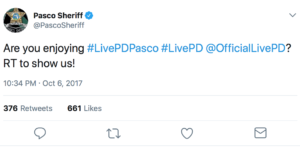PR Implications of “Live PD”
Published on April 19, 2018, at 9:39 p.m.
by Alyssa Comins.
On Friday and Saturday evenings, loyal “Live PD” fans forgo other forms of weekend entertainment and turn on their televisions for three hours of traffic stops, car chases and arrests. A&E’s hit documentary series aims to give viewers an unfiltered look inside law enforcement agencies during a time in which policing in the United States is heavily scrutinized. Over 2 million people tune in to the show each week, meaning “Live PD” consistently posts higher ratings than all other programs airing during its time slot. Fans are so enthralled with the series they have created several Facebook fan clubs and often get #LivePDNation to trend on Twitter with their live-tweeting frenzy.

But not everyone is a member of #LivePDNation. There are those who claim the show is disturbing and fails to offer balanced and unbiased coverage of the country’s police forces. Critics frequently worry about the privacy of those who unwillingly appear on “Live PD.” Furthermore, several departments have ended their contracts with the show due to concerns about the reputational damage it might cause to the cities and counties they represent.
Although both fans and critics have strong opinions about “Live PD,” the show presents an interesting case study for public relations students and practitioners. There are several facets to consider. Does the show have a negative effect on the public image of participating cities? How does the series impact police-community relations, and is there an advantage to the social media conversations viewers and law enforcement agencies have about how officers handle certain situations? If the show truly increases transparency, do involved parties benefit from the candid look at policing across America?
Impact on the reputation of participating cities
Streetsboro, Ohio, is a small city with a population of just over 16,000. The Streetsboro Police Department was featured on six episodes of “Live PD” before ending its time with the show due to limited resources and staffing concerns.
Carmen Laudato serves as the council at-large on the Streetsboro City Council. She said she used to tune in to “Live PD” but no longer watches after its time in Streetsboro. Laudato feels the show does not accurately represent participating cities and believes it gives locations featured on the show a negative reputation.
Streetsboro Police Lt. Tricia Wain disagrees with Laudato. Wain said she understands some people are concerned about how their city was represented on national television but thinks citizens who believe they live in a city without any crime are simply unaware.
“There is no city in this country that has no crime, or no drugs, or no alcohol-related incidents or crashes. It’s out there. It’s everywhere,” Wain said. “Are there certain areas in cities that have a higher crime rate than others? As in most cities, there probably are. But I don’t think the show focused on any one particular area to give it a bad reputation.”
John Guilfoil is a former Boston Globe reporter and deputy press secretary to Boston Mayor Thomas M. Menino. Guilfoil now owns his own public relations firm, John Guilfoil Public Relations, that specializes in communication strategy for police departments, firefighters and government agencies. Guilfoil said he believes politicians should not be afraid of shows like “Live PD.”

“I think politicians should welcome a transparent look at what their police department is doing over the course of an evening, or a week, or a month. I don’t think it’s a bad thing,” Guilfoil said. “Does it expose that there are darker sides to a community? Sure, but virtually every community in America has a police department for a reason, and it’s not just to direct traffic.”
Effect on police-community relations
In a time where tensions are on the rise between police and the people they are trusted to protect, “Live PD” producers hope to offer an unfettered look at police departments across the country. However, Laudato believes local police officers were well-respected by community members before the show came to Streetsboro. She is not convinced “Live PD” positively impacted police-community relations in her city.
“I don’t think it’s done anything to benefit the public’s perception of what the police do or how they handle issues. If anything, I think it would have made it worse,” Laudato said. “Many people [on the show] feel like their rights are being violated, like it’s an invasion of privacy. And if people are already having misgivings about the police nationwide, that they’re not respecting the rights of the individual, I don’t think the show does anything to help that.”
Chase Daniels works as the assistant executive director of the Pasco County Sheriff’s Office, which has been featured on “Live PD” since October 2017. Daniels said he believes “Live PD” has been a great way to show the residents of Pasco County what their sheriff’s deputies do on a daily basis.
Daniels said many people think deputies spend most of their time writing speeding tickets or arresting people for misdemeanor drug charges. But that is just a small portion of what officers do for their communities. Daniels said “Live PD” presents a different, more accurate view of law enforcement.
“‘Live PD’ shows the caring and the compassion. They show someone having a bad day, maybe had too much to drink, and [a deputy] making sure they get home safely,” Daniels said. “We are not there to ruin someone’s day. We are not there to ruin someone’s life. We are there to keep the community safe. I think the more that people see those positive interactions, the better.”
Wain said her department received a lot of positive feedback from community members, and she hopes the perspective “Live PD” offers will encourage people across the country to view law enforcement officers in a more positive way.

“We are friendly. We are human. We are your neighbors, your family members,” Wain said. “We treat people with respect. I think [‘Live PD’] is showing the public that we aren’t some robotic force out to only enforce the law. There’s more to what we do.”
Influence of engaging conversations between citizens, experts and police
While most think the live aspect is what makes the show special, Guilfoil views it as more of a gimmick (the show actually runs on a 10- to 25-minute time delay). For Guilfoil, the most interesting, important and often undervalued aspect of “Live PD” is the expert analysis included in each episode.
“A decent percentage of the show is analysis. They have experts in law enforcement and criminal justice in the studio with a journalist from the network doing analysis in real time,” Guilfoil said. “So, you’re receiving the context and intellectual review of what’s going on that you don’t get from ‘Cops’ or other types of reality shows that look at law enforcement.”
Another unique aspect of “Live PD” is the extensive use of social media by fans and law enforcement agencies. There have been times where viewers watching at home caught something on television an officer did not. Some departments follow along on social media and send officers back to investigate when viewers notice something strange. “Live PD” fans have even helped law enforcement officers locate missing children and criminals on the run.
Daniels said “Live PD” has a very large Twitter audience, and the Pasco County Sheriff’s Department likes to live-tweet during the show, especially when its department is featured.

“A typical social media day for us, just for example, we will usually average somewhere around 500,000 impressions a day on Twitter,” Daniels said. “On days with ‘Live PD,’ so Friday and Saturday, we are much closer to 1.5 million impressions. We will usually triple our audience during the show. We are around 64,500 followers on Twitter, and it’s nothing to gain 500 followers in a weekend because of ‘Live PD.’”
Guilfoil said he is a firm believer in the benefits of engaging constituencies in two-way dialogue. He noted that companies in the airline industry converse with their customers frequently, and these exchanges have a way of humanizing corporate brands. Guilfoil believes the same strategy works well for law enforcement agencies.
“At face value, I think it’s a good thing that police departments are talking to people in real time,” Guilfoil said. “The more people they can talk to, the better it is, the more legitimate it is.”
Guilfoil said five years ago, a large percentage of his clients were not on Twitter or Facebook. Recently, he has noticed that even small-town police departments are live-tweeting their shifts and engaging in a dialogue with their publics.
“The more we talk, the more context there is. The more we explain to people, the more context there is. And the more context there is, the more understanding there is,” Guilfoil said. “To me, if people don’t have to ask ‘Why did you do that?,’ because they understand what’s going on — why [police] park a certain way when they pull a car over, why they flash a light a certain way, why an officer would draw a weapon, for example — if people understand that, it’s a good thing for everybody.”
“Live PD” will likely remain a controversial show, but Daniels said he views the series as a beneficial public relations tool.
“I think it’s just been a very positive experience for us. We’ve got nothing bad at all to say about it,” Daniels said. “It’s been great for us, and we’ve had a very good relationship with the show, with the producers and with our community.”




